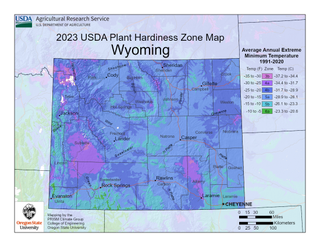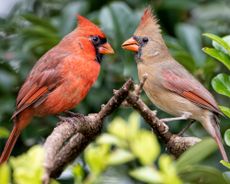Wyoming Planting Zones - USDA Map Of Wyoming Growing Zones

Click on the image above to see a larger version.
About Wyoming USDA Plant Hardiness Map
The USDA revealed its Internet friendly plant hardiness map at the end of 2023. This map replaces the less sophisticated 2012 version and has made some significant changes using accurate data collected over a thirty-year period. Plant hardiness zones represent annual extreme winter low temperatures averaged over time. Gardeners across the country depend on this information when selecting plants for their home landscape.
The Wyoming planting map above outlines the hardiness zones within the state. Most of the state experiences very cold winter temperatures; however, there are some warmer pockets. To find your zone you can click on the map to enlarge it.
While there are perennial flowers, trees, and shrubs that will do well in the cold Wyoming winter, it is essential to know which ones these are before planting. Failure to consider which Wyoming zone you are in could lead to plant failure and disappointment.
For best results when planting anything in your garden or landscape, always follow the planting and care guidelines in addition to choosing plants that are appropriate for your Wyoming zone. Reputable nurseries in your area will only carry plants that are clearly marked with the USDA planting zones that are appropriate for the plant that is for sale.
Gardening tips, videos, info and more delivered right to your inbox!
Sign up for the Gardening Know How newsletter today and receive a free download of our most popular eBook "How to Grow Delicious Tomatoes."
-
 Cheap Fence Ideas For A Pretty And Private Yard
Cheap Fence Ideas For A Pretty And Private YardYou don’t need to spend a fortune to box in your garden. Take these cheap fencing ideas for your garden and budget and run with them.
By Mary Ellen Ellis
-
 How To Attract Cardinals – Get Beautiful Songbirds Flocking To Your Yard
How To Attract Cardinals – Get Beautiful Songbirds Flocking To Your YardThe northern cardinal is a national treasure and a delight to spot in the garden, nesting in shrubbery and flitting between feeders. Discover how to attract this beloved songbird by providing the right food, shelter, and water.
By Melanie Griffiths